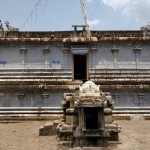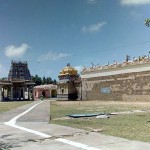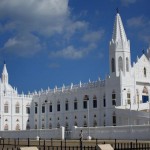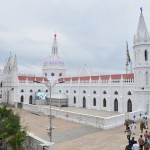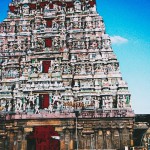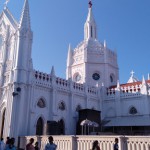Upgrade & Secure Your Future with DevOps, SRE, DevSecOps, MLOps!
We spend hours scrolling social media and waste money on things we forget, but won’t spend 30 minutes a day earning certifications that can change our lives.
Master in DevOps, SRE, DevSecOps & MLOps by DevOps School!
Learn from Guru Rajesh Kumar and double your salary in just one year.
| Nagapattinam Districts |
| About: |
| The modern Nagapattinam district was carved out of the earlier composite Thanjavur district in 1991. Tamil is the main language spoken in the district. The marine or coastal land has plain lands except for a few sand dunes and tilts from coastline to the inland area. The Vedaranyam salt swamp, south of Nagapattinam town is the largest swamp in Tamilnadu, running 7-8 kms. wide and 48 kms. along the coast from Point Calimere. It is one of the richest regions of biodiversity in the country.Nagapattinam District was formerly a part of Thanjavur District. The district boundary is shared by Tiruvarur, Karaikal, Tanjore and Cuddalore districts. Its population at the 2001 Census was nearly 1.5 million. It is divided into seven taluks. All but two of them are coastal, and all are named after their main towns, which are their administrative centres. From north to south, they are Sirkazhi, Tharangambadi, Mayiladuthurai (non-coastal), Nagapattinam, Kilvelur, Thirukkuvalai (non-coastal), and Vedaranyam. It is bordered on the east by the Bay of Bengal and on the south by the Palk Strait. On the coast between Tharamgambadi and Nagapattinam lies the small district of Karaikal, an enclave belonging administratively to the Pondicherry Union Territory.The Nagapattinam district lies on the east coast to the south of Cuddalore district and another part of the Nagapattinam district lies to the south of Karaikkal and Tiruvarur districts. Its northern boundary is about 75 Km southwards from the Head Quarters of the Cuddalore district. Thanjavur district and Tiruvarur district flank it on the west and on the south and east it is bordered by the Bay of Bengal. This District lies on the shores of the Bay of Bengal between Northern Latitude 10.7906 degrees and 79.8428 Degrees Eastern Longitude. The general geological formation of the district is plain and coastal. The Cauvery and its offshoots are the principal rivers.Nagapattinam is a coastal District on the Eastern Coast of India in the State of Tamil Nadu with a long coastline of 187 km. The district is famous for the ancient site of Poompuhar and the Point Calimere Bird & Wild Life Sanctuary. It is also pilgrimage destinations for its famous Nagore Dargah, Shrine Basilica at Velanganni (a la Lourdes of the East) and historically important Hindu temples at Sirkali, Sikkal, etc. Living at the tail end of the Cauvery river basin – the Rice Bowl of the South – the half million farmers and farm workers of this agrarian district constantly fight the elements of floods and droughts year after year. With saline ground water and the oft un-assured irrigation from the Cauvery, the paddy crop, which is the lifeline of the district, is dependent on rains. Temples of Nagapattinam district are best known for the wide array of temple festivals. Nagapattinam district is located on the shores of the Bay of Bengal in Tamil Nadu. Tourists from various places come to visit the sacred places like Poombuhar, the temple of Lord Anjaneyar, Dargha in Nagore near Nagapattinam, Sowriraja Perumal Temple, Shri Kayahorana Swami Neelayathatchi Amman Temple, and Nellukkadai Mariamman Temple and the virgin beaches. |
| The marine land or coastal land has plain lands except for few sand dunes. However there is a general tilt from coastal line to inland area. The most important feature of the district is the Cauvery River spread over with its numerous branches. |
| Location info: |
| Nagapattinam District,Tamil Nadu,India |
| Climate/Weather of Nagapattinam Districts: |
| Temperature: The average maximum temperature for the district (from 1991 to 1996)as a whole is about 32.460 C and the average minimum temperature is 24.750C. |
| History of Nagapattinam Districts: |
| Nagapattinam has always played an important role in the history of Tamil Nadu. The importance that this beautiful port-town has enjoyed in the affairs of Tamil Nadu is a factor that has remained constant in both the politics as well as the economy of Tamil Nadu even today. Reference to the district dates back to the Sangam Era when the district was ruled by the Cholas and the Pandyas. A number of architectural glories of the era are instrumental in pointing out to modern historians of the role that Nagapattinam enjoyed as a major power in the history of Tamil Nadu. Nagapattinam was also an important center of the tsunami that hit the coast of peninsular India in 2005, an unfortunate event whose influence can still be seen today while on a tour to Nagapattinam. |
| Educational Institutions of Nagapattinam Districts: |
| Arts & Science:D.G. Govt. Arts College for Women, Nagapattinam Government Arts College, Kumbakonam Government College for Women, Kumbakonam Kundavai Nachiyar Govt. College for Women, Thanjavur M.R. Govt. Arts College, Tiruvarur Rajah Serfoji Govt.Arts College, Thanjavur Thiru-Vi-Ka Govt. Arts College, Thiruvarur A.D.M. College for Women, Nagapattinam A.R.C. Viswanathan College, Mayiladuthurai A.V.C. College (Autonomous), Nagapattinam A.V.V.M. Sri Pushpam College (Autonomous), Thanjavur Abi and Abi College, Thanjavur Adaikala Matha College, Thanjavur Annai College of Arts and Science, Thanjavur Best Arts and Science College, Sirkali Taluk Bharath College of Science and Management, Thanjavur Bon Secours College for Women, Thanjavur Dharmambal Ramasamy Arts and Science College, Thanjavur Dharmapuram Adinam Arts College, Nagapattinam Dr. Nallikuppusamy Arts College, Thanjavur Edaiyathangudi G.S. Pillai Arts and Science College, Nagapattinam Enathi Rajappa College of Arts and Science, Pattukkottai Ganesar Senthamil Kallori, Thanjavur Idhaya College of Arts and Science for Women, Kumbakonam Khadir Mohideen College, Thanjavur Manickam College of Arts and Science, Thanjavur Maruthupandiyar College, Vallam Mass College of Arts and Science, Kumbakonam Meenakshi Chandrasekaran College of Arts and Science, Pattukkottai Moti and Moti Arts and Science College, Thanjavur, Thanjavur Nethaji Subash Chandra Bose College, Thiruvarur Ponnaiyah Ramajayam College, Thanjavur Poompuhar College, Nagapattinam Rabiammal Ahamed Maideen College for Women, Tiruvarur Rajagiri Dawood Batcha College of Arts and Science, Thanjavur Rajahs College, Thanjavur S.K. College of Arts and Science, Mannargudi S.K.S.S. Arts College, Thiruppanandal Sami Arul Arts and Science College, Thanjavur Semgamala Thaayar Educational Trust Women’s College, Tiruvarur Sri Sankara Arts and Science College, Kumbakonam Sri Venkateswara College of Arts and Science, Thanjavur Sulthana Adbullah Rowther College for Women, Thanjavur T.T. Narasimhan – Swami Dayananda College of Arts and Science, Thanjavur Tamilavel Uma Maheswarnar Karanthai Arts College, Thanjavur Vivekananda Arts and Science College for Women, Sirkali Taluk |
| Langauge |
| Tamil, Malayalam (due to its proximity to Kerala) and English are widely spoken by the people. |
| Culture: |
| The culture is a mixture of Tamil Nadu and Kerala. Christianity, Hinduism and Islam are the main religions practiced, with Christians accounting to nearly half of the populace. Some of the communities in the district are Nadars, Nanjil Nadu Vellalars, Paravas, Mukthavas, Vilakki Thalanayar, Kammalar or Asari, Chackarevars, Kerala Mudalis etc.Fairs And Festivals:The festivals of Nagapattinam are varied and add an extra spark of life to the town’s daily lives. Notable among these are:PongalPongal is definitely one of the main festivals of Nagapattinam, being regarded as one of the most important festivals in the entirety of Tamil Nadu.KandhooriKandhoori is one of the most important festivals of this port-city being celebrated in the month of December each year. |
| How to reach? |
| Nearest Railway Station:It has a well maintained network of rails connected with all major cities in South India via Chennai, Tiruchirappalli, Thanjavur and Kollam. |
| Nearest Airport:Nagapattinam is Tiruchirappalli Airport |
| Road Transport:Connected to all major towns and cities; regular bus services available to Chennai, Madurai, Tiruchirappalli, Pondicherry etc. |
| Tourist Attraction of Nagapattinam Districts: |
| Flora at Point Calimere Sanctuary: The diversity of habitats makes the vegetation of the Point Calimere Wildlife Sanctuary quite diverse. This diversity ranges from dry evergreen forests, salt marsh, mangrove vegetation to grasslands. Of all the trees present in the forest, Manilkara hexandra and Salvadora persica are the dominant ones. You can also spot some insectivorous plants such as Drosera burmanii and D Indica. The marshy areas of the shore are home to Salicornia brachiata and Sessuvium portulacastrum while Calotropis gigantea, Prosopis chilensis and Pandanus tectorius occur in elevated regions.Fauna at Point Calimere Sanctuary: Point Calimere Sanctuary is most famous for its flamingos and blackbuck. There is no end to your excitement at the sanctuary as you get to spot a vast variety of water birds such as plovers, teals, terns, gulls etc. Fourteen species of mammals have been reported from the Point Calimere Sanctuary. The larger mammals include the blackbuck, wild boar, spotted deer and jackal. Another interesting creature at the sanctuary is the flying fox that resides in large groups on trees. The water birds in the great swamp and the dolphins and turtles that often come quite close to the shore are interesting to see.Agneeswarar Temple: Agneeswarar Temple is one of the well-known Temples of Nagapattinam district. This is a Shivasthalam located at Annur and was built by Chola rulers. Dedicated to Lord Shiva, the temple enshrines Agneeswarar as the chief deity along with his divine spouse Goddess Parvati. Mythology says that Agni worshipped Lord Shiva at this place. Arudra Darisanam is the famous annual festival celebrated here amid much pomp and splendor. Naganathaswamy Temple, located at Kizhaperumpallam is again dedicated to Lord Shiva. However this temple also has a separate shrine for Kethu. It is believed that the king of serpents, Vasuki, did penance and worshipped Lord Shiva at this place.Sri Devathirajan Temple: Sri Devathirajan Temple, one among the famous temples of Nagapattinam district, is situated in Therezhandur village in Mayiladuthurai and the main deity of the temple is 10 foot tall with Garuda balanced to his left and Prahlad along with Markanteya Maharishi to his right. The idol is decorated with a golden kireedam (helmet), sagasranama necklace and golden anklet. The main festivals of the temple are the Sri Ramar Utsavam and Vasantha Utsavam in Chithirai, Brahma Utsavam in Vaikasi, Sri Andal Utsavam in Aadi. Located at Poompuhar, Tiruchaaikadu Temple is a shaivite shrine and an important temple of Nagapattinam district.Vyagrapureeswarar Temple: Vyagrapureeswarar Temple is a famous shrine located at Puliyur, about 7 km from Nagapattinam. Lord Shiva is worshipped here in the form of Vyagrapureeswarar, along with Goddess Parvati. The temple complex also has separate shrines for Durga, Dakshinamurthy, Mariamman, Goddess Lakshmi and Surya. Nagore Dhargah and Tiruvarur Thyagaraja Temple are nearby attractions. Iravatheswarar Temple is a highly honored temple of Nagapattinam district, located at Maelai Thirumananjeri close to Mayiladuthurai. This temple is dedicated to Lord Shiva.Shanmugar Temple: Shanmugar Temple with the deity Lord Muruga in standing posture along with his consorts Valli and Devayanai, bears inscriptions from the temple that reveal the history of the Chola period. There are separate shrines for Bhramapureeswarar, Anandavalli, Dakshinamurthy and Mahalakshmi in the temple. Skanda Shashti, the major festival here. Mayuranathar Temple is one of the important temples of Nagapattinam district with a unique blend of fine sculpture and exquisite architecture. Airavateswarar Temple, Neelamegaperumal Temple, Tiruppunkur Sivalokanathar Temple, Tiruchaaikadu Temple and Arulsomanathar Temple are some more important temples of Nagapattinam district.Rock Fort Temple: This temple sits pretty atop a mammoth piece of rock which rises from the plains, soaring to a height of 83 meters. The Rock fort temple is a combination of three temples, of which The Sri Thayumanaswamy Temple dedicated to Lord Shiva – halfway up is the most famous and visited temple complex by the devotees. The temple has a 100-pillared hall, and a Vimana completely covered with gold, which more often than not captures the imagination of the onlookers. There are several remarkable rock-cut cave temples on the southern face of the rock, dating back to the Pallava period, which perfectly compliment the resplendence of the Rock Fort. This temple site is also the chosen venue for the famous Carnatic wars between the French and English, which was fought around this rock.Sri Jambukeshwara Temple: The Sri Jambukeshwara Temple is located 5 km from the town, dedicated to Lord Siva. The legend has it that an elephant worshiped Lord Shiva near the Jambu tree, hence the temple was named Jambukeshwara. There are seven gopurams and 5 concentric walls, which are completely covered with splendid carvings. These carvings are so life-like that they virtually transport the beholder into the past realm. It is built around a Siva Lingam, which is completely submerged in water that comes from a spring in the sanctum sanctorum. Although non Hindus are not allowed inside the temple, but such tourists can experience the structural beauty of the complex from outside which also is worth the time. The temple is open daily between 6 am to 1pm and between 4pm to 9.30pm.Samayapuram Mariamman Temple: Samayapuram Mariamman Temple is located 12 km north of the city junction on Trichy-Chennai highway. The Maariamman Temple is one of the most visited shrines in Tamil Nadu. The temple is dedicated to Maariamman, who is a form of Goddess Shakti associated with prosperity and health. Locals believe that the deity cures diseases such as Small Pox and Chicken Pox. The walls of the temple have carvings of Goddess Shakti in her various manifestations and also other heavenly sculptures of various Gods.Srirangam (Sri Ranganathaswamy Temple): The temple of Sri Ranganatha is the largest temple in India. It is of great importance to all Hindus as it is considered to be the supreme temple dedicated to Lord Vishnu. The temple is located some 6 km from Trichy and is on the banks of River Kaveri. This 13th century temple is surrounded by seven scintillating rectangular courtyards and has 21 spectacular gopurams, among which Rajagopuram is the largest in India. The walls and surroundings of the temple are rich in brilliant carvings and wonderful paintings that have proved to be a great attraction for the tourists.Velankanni: One of the most pilgrimage centers for Christians in India, the beautiful city of Velankanni is located just about 12 kms away from Nagapattinam. Declared by the Pope as a Holy City, the city is famous for a shrine dedicated to “our lady of sorrow” where the sorrowing Mother is depicted carrying infant Jesus in her hand.Tranquebar (Tharangambadi): Located just about 35 kms away from Nagapattinam, this quaint city still exhibits some of the most brilliant influences of Danish architecture. These include the Archeological Museum, Zion’s Church, Town Gateway, Masilamani Nathar Temple and the Danish Governor Bungalow.Kodiakkarai: Kodiakkarai, located around 55 kms away from the main town of Nagapattinam is one of the best places for excursions from Nagapattinam. Also called Point Calimere, this beautiful town is home to a wildlife sanctuary, where you can see nature in its purest form.Sikkal: Home to one of the most famous shrines of Lord Muragan, this beautiful town is homage to Lord Singaravelan, one of the most revered deities of Tamil Nadu. |
| Hotels/Lodge/Accommodation in Nagapattinam Districts: |
| Seagate Group of Hotel:Main Road, velankanni, Tamil Nadu,Ph:04365 263510Indeco Hotels Swamimalal:6/30 B Agraharam, Thimmakudi village, (formerly Sterling Swamimalai), Kumbakonam, Tamil Nadu,Ph:0435 2480044Comfort Inn MGM Resort:64/f2 Nagapattinam Main Road, Nagappattinam,Tamil NaduPh:04365 263900Vailankanni Hotel:#52 Main Road, Vailankanni, Tamil Nadu,MO:09842635544 |
| Links: |
